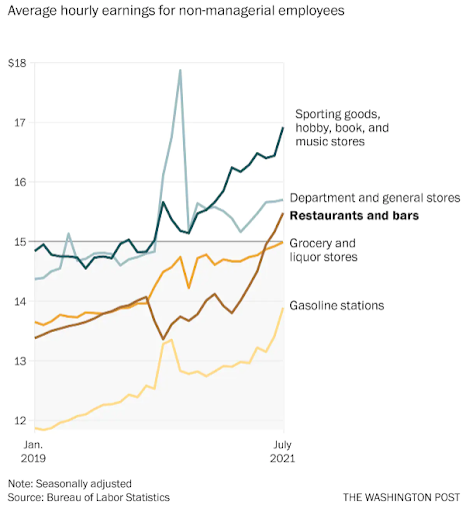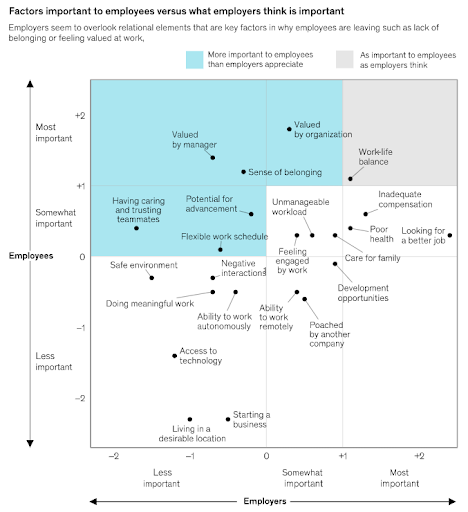Grocery store workers stood at the front lines of the COVID-19 pandemic, putting these employees at significantly higher risk of contracting and spreading the virus. In response, many stores across the country installed one-way aisles, enforced strict social-distancing requirements, and increased contactless shopping accessibility to protect these essential workers.
For the first time in history, supermarket workers in the U.S. were earning more than $15 an hour. There was a significant and rapid increase in wages designed to provide employees with adequate compensation for the risks associated with working in COVID-19-affected areas. (Dam & Long, 2021)

Recruiting highly qualified candidates and enhancing employee benefits in an effort to increase retention have all contributed to changes in grocery store employment in the 21st century. While COVID-19 has been singularly responsible for transforming grocery store employment, changes across the board have been taking place incrementally over the past two decades.
Turnover in the Grocery Industry
As of 2022, the number of people employed in the Supermarkets & Grocery Stores industry in the United States is nearly three million. Every aspect of the company's people model, whether it be corporate, in-store, or at every level of the operation, is experiencing a structural upheaval due to a rise in absenteeism and attrition as well as demands from employees for flexible work schedules. A dramatic drop in workforce participation was recorded during the pandemic; as of August 2021, it was still 1.6 percentage points below pre-pandemic levels. Additionally, automation is changing the workforce dynamic. (IBISWorld, 2022)
The pandemic has cost grocery stores a great deal to hire and retain workers. Over half of the $24 billion spent by food retailers on pandemic-related expenses between March 2020 and March 2021 went directly to employees, according to FMI, with $12 billion spent on increased pay and incentives, $5 billion on benefits and $1 billion on non-monetary incentives and vaccine incentives. (FMI, 2021)
However, labor remains one of the industry's greatest challenges in spite of these investments. A recent survey by the Food Industry Association (FMI) revealed that 80% of retailers face hiring challenges. The industry increased employee incentives in 2020, with 85% of respondents saying they increased wages and benefits. Despite their efforts, retailers have seen an overall turnover rate rise from 40% to 58%. (Moran, 2021)
In the food retail industry, 2020's turnover rate was the highest in a seven-year period, according to the Food Marketing Institute. Part-time employee turnover increased to 74% in 2020 from 52% in 2019. Among full-time employees, the turnover rate was 22%, compared to 13% in 2019, and among corporate employees, the turnover rate was 15%, compared to 11% in 2019. (FMI, 2022)
Turnover in the grocery industry has a big price tag. A high turnover, especially in part-time workers, has long plagued grocery stores. As a result of low wages, a lack of company loyalty, and a lure of better opportunities, part-time employees have a turnover rate of 48.9%, reports a survey by National Grocers Association. The average cost of replacing such an employee is somewhere near $4,200, per the data from Coca-Cola Retailing Research Council. Combining all these factors, SMB Benefits Advisor, Chris Cooley, estimates that an average cost of turnover per grocery store accumulates to $67,200. (CCRRC 2017, Griffith 2017, NGA 2017)
It can be extremely difficult for grocers to advance their business if they have high turnover rates. The average cost of these changes to employers in the supermarket industry is $190,000. Small businesses and local grocers do not face the same high costs and turnover problems. However, every grocery store strives for their turnover rates to stay as low as possible, as well as to keep their greatest employees for as long as possible. (Goodwin, 2021)
How Grocers Can Combat Turnover
The US retail industry still has about one million open positions, despite increased year-end bonuses and tuition assistance for in-store employees. In response, grocery stores have been stepping up their efforts to retain their employees and improve their skills as a result of fierce competition for retail employees resulting in higher wages and benefits.
Before jumping into the solutions, it's important to understand how the grocery industry has evolved amid the pandemic and how it translates to their hiring challenges ahead:
- New shifts in skills and operations. During and post-pandemic, the grocery industry saw a great shift to e-commerce shopping as consumers resorted to shopping for their groceries online rather than visiting stores. Subsequently, grocers must adapt to a faster delivery mechanism by offering faster or instant delivery models. Additionally, a rise in demand for sustainable eating will force grocery chains to seek higher collaboration with their suppliers. Grocery employees will need to upskill as new roles start emerging, and companies will need to evolve their operations with these changing dynamics. (Chandra et al., 2022)
- Rising cost pressures. A decline in market growth, the rise of inflation, the pressure to increase wages, the rise of competition, and the high attrition rates of recent years are all factors that contribute to the need for higher efficiency and productivity. The pandemic has further accelerated this trend pushing grocery retailers to transform their business and people to adapt.
- Likeliness of automation is high in the industry. Research suggests that over the next eight years, one-third of all grocery retail tasks will be automated. However, only a few jobs can be completely automated, so the challenge is not when to eliminate them but when to determine how much they will change and how workers can adapt. With the increase in automation, workers will have to adjust, assuming additional - and often rewarding - tasks, such as interacting with customers more often while acquiring new skills. (Simon et al., 2020)
Over the past two years, there has been a dramatic change in the talent landscape. There was a time when retail positions were highly desirable, offering flexible hours, product discounts, and other perks. Today, other sectors offer the same or even better value propositions. A "Hiring Now" sign and an online advertisement are not enough to attract workers, given the current labor shortages.
McKinsey, in their 2022 State of Grocery North America report, highlighted three key factors that can contribute to hiring and retaining grocery and supermarket employees (Aull et al., 2022):
- Digitized hiring. Automation of resume screening can reduce manual effort by 55 percent with predictive analytics. The advantages of automatic screening include that store managers can spend more time on activities such as coaching and analysis, which are more directly related to improving the store's performance. In addition to understanding which candidate personas are likely to succeed in their business, retailers can also use these analytical tools to take early action to retain these candidates.
- Digital training. Employees can benefit from digital training once they are hired. One major retailer has introduced virtual reality (VR) training to their associates to improve efficiency and gamified digital training programs at their locations across the US to improve employee engagement and retention.
- AI-powered workforce scheduling and planning. In addition, using AI to plan and schedule a store's workforce can save them over 10 percent in labor costs as a result. With these tools, demand can be predicted based on variables outside the store, such as traffic patterns and weather patterns, as well as store-specific information. Retailers can use these insights to match staffing to the needs of their individual stores, while giving workers the schedule stability they need.

Employers and employees seem to hold different views about what is important. In the past 18 months, we have seen that employees are demanding investments in human capital: better pay, better benefits, and better perks. Employees really desire social and interpersonal connections with their colleagues and managers, as well as to feel valued by their organizations. In order to accomplish this, in-store personnel must be properly onboarded and motivated in the long term.
That said, there are plenty of ways to ensure that your workforce not only remains loyal to you but is engaged and motivated to do the work:
- Enable flexible scheduling. Survey results show that 63 percent of hourly managers see scheduling control as the greatest incentive for prospective employees, followed by greater transparency regarding shift assignments and hours given. Giving store associates more flexibility with their schedules will result in happier and more engaged employees. A key to maximizing conversion is aligning frontline labor with visitors' visit times. The manager of a store needs to closely monitor traffic trends in their store to ensure they have adequate coverage during peak traffic periods, and then make adjustments as conditions change. Although flexible schedules make this more challenging, ultimately happier employees will perform better. (Jones, 2022)
- Offer on-demand pay. A majority of U.S. employees (83%), would like to access their wages before payday. When you allow your employees to access their earned pay, they are able to keep up on their bills and save for emergencies. Thus, you will see a reduction in turnover costs, while your customers will receive an improved level of service from happier employees. Less financially stressed employees are productive, more engaged at work, and less likely to leave their organization. (Segal, 2021)
- Prioritize professional development. Establish a supportive work environment to show your employees that you care about their development. Organizing informal training on relevant industry topics can be a great way to get started. Many grocery retailers have hired full-time training specialists who can continually assist their employees in developing their skills. Educating employees about the variety of career opportunities available in the grocery industry is crucial. In this way, they can better understand where they are and what they need to do to progress. (Durevall, 2022)
References
Aull, B., Coggins, B., Kohli, S., & Marohn, E. (2022, May 18). The state of grocery in North America. McKinsey. Retrieved November 25, 2022, from https://www.mckinsey.com/industries/retail/our-insights/the-state-of-grocery-in-north-america-2022
Chandra, V., Gill, P., Koli, S., Mathur, V., Venkataraman, K., & Yoshimura, J. (2022, April 29). The next horizon for grocery e-commerce: Beyond the pandemic bump. McKinsey. Retrieved November 24, 2022, from https://www.mckinsey.com/industries/retail/our-insights/the-next-horizon-for-grocery-ecommerce-beyond-the-pandemic-bump
Coca-Cola Retailing Research Councils (CCRRC). (2017, August 29). The Importance of Employee Engagement. Coca-Cola Retailing Research Council. Retrieved November 24, 2022, from https://www.ccrrc.org/2017/08/29/importance-employee-engagement/
Durevall, H. (2022, April 7). How You Can Improve Your Retail Employee Retention Rate. flair.hr. Retrieved November 24, 2022, from https://flair.hr/en/blog/retail-employee-turnover-rate/
FMI. (2021, September 15). New FMI Food Retail Survey Reveals E-Commerce Sales Growth Tempered by Pandemic-related Expenses and Ongoing Labor, Supply Chain Challenges. fmi.org. Retrieved November 25, 2022, from https://www.fmi.org/newsroom/latest-news/view/2021/09/15/new-fmi-food-retail-survey-reveals-e-commerce-sales-growth-tempered-by-pandemic-related-expenses-and-ongoing-labor-supply-chain-challenges
The Food Industry Association (FMI). (2022). FMI | Food Retailing Industry Speaks. Food Marketing Institute. Retrieved November 25, 2022, from https://www.fmi.org/our-research/research-reports/food-retailing-industry-speaks
Gaga, L., & Cooper, B. (2022, January 17). ??? ??? - YouTube. Retrieved November 24, 2022, from https://www.forbes.com/sites/edwardsegal/2021/09/13/most-workers-want-to-be-paid-automatically-every-day-according-to-new-poll/?sh=13137878293f
Goodwin, G. (2021, September 2). 5 Simple Ways for Grocers to Retain Employees. IT Retail. Retrieved November 23, 2022, from https://www.itretail.com/blog/5-simple-ways-for-grocers-to-retain-employees
Griffith, L. (2017, September 15). HR & Benefits News: The Real Cost Of Worker Turnover For Grocers. The Shelby Report. Retrieved November 25, 2022, from https://www.theshelbyreport.com/2017/09/15/hr-benefits-news-turnover-costs/
IBISWorld. (2022, July 19). Supermarkets & Grocery Stores in the US - Employment Statistics. IBISWorld. Retrieved November 23, 2022, from https://www.ibisworld.com/industry-statistics/employment/supermarkets-grocery-stores-united-states/
Jones, K. (2022, June 14). New Research Shows “Great Resignation” Slowing But Hourly Employees Remain Deeply Dissatisfied. businesswire.com. Retrieved November 25, 2022, from https://www.businesswire.com/news/home/20220614005418/en/%20percent%20C2%20percent%20A0New-Research-Shows-%20percent%20E2%20percent%2080%20percent%209CGreat-Resignation%20percent%20E2%20percent%2080%20percent%209D-Slowing-But-Hourly-Employees-Remain-Deeply
Mathew, R., Rastrollo, B., Simon, P., & Speich, R. (2022, March 31). Crisis or opportunity? How grocers can build stronger people models. McKinsey. Retrieved November 25, 2022, from https://www.mckinsey.com/industries/retail/our-insights/crisis-or-opportunity-how-grocers-can-build-stronger-people-models
Moran, C. D. (2021, September 16). FMI: 80% of food retailers say hiring issues are hurting business. Grocery Dive. Retrieved November 25, 2022, from https://www.grocerydive.com/news/fmi-80-of-food-retailers-say-hiring-issues-are-hurting-business/606695/
National Grocers Association (NGA). (2017, May 15). 2017 Independent Grocers Survey Released. National Grocers Association. Retrieved November 24, 2022, from https://www.nationalgrocers.org/news/2017-independent-grocers-survey-released/
Simon, P., Tufft, C., & Zampella, P. (2020, August 28). Reinventing retail with people analytics. McKinsey. Retrieved November 25, 2022, from https://www.mckinsey.com/industries/retail/our-insights/closing-the-skills-gap-in-retail-with-people-analytics
Simon, P., Tufft, C., & Zampella, P. (2020, August 28). Reinventing retail with people analytics. McKinsey. Retrieved November 25, 2022, from https://www.mckinsey.com/industries/retail/our-insights/closing-the-skills-gap-in-retail-with-people-analytics
Van Dam, A., & Long, H. (2021, August 8). Average pay for grocery store and restaurant workers is now over $15 an hour. The Washington Post. Retrieved November 23, 2022, from https://www.washingtonpost.com/business/2021/08/08/fifteen-dollar-wage/

